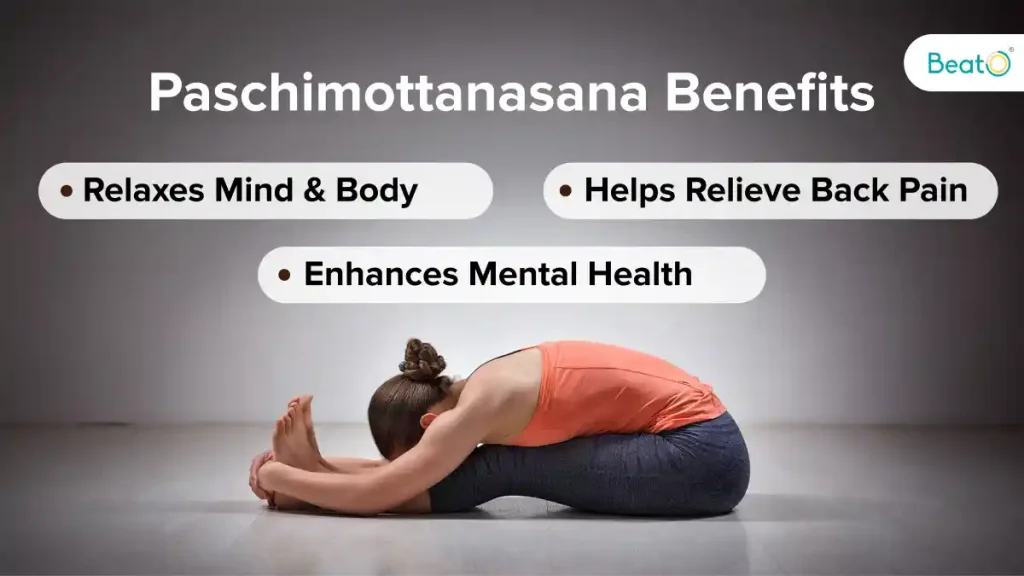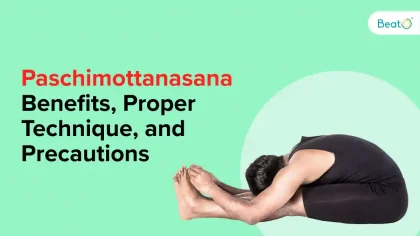With different yoga poses offering unique advantages, yoga can be a great way to boost your overall health while increasing your strength and flexibility. So, if you’ve set up your yoga mat and want to start with an exercise that can ease back tension from sitting too long, you might want to try Paschimottanasana yoga.

Paschimottanasana is a top pick among hatha yoga poses for giving your body a thorough stretch. Paschimottanasana benefits are impressive, especially for individuals dealing with issues like high blood pressure and diabetes. To make the most of Paschimottanasana, it’s best to practice it in the morning as part of your hatha yoga routine.
This pose is part of the traditional Hatha Yoga, known for its simplicity and numerous body and mind benefits. It involves a straightforward stretch from head to heels, helping to awaken your Kundalini energy.
What is Paschimottanasana?
Paschimottanasana, also known as the seated forward bend pose, and the name of the aasana has its roots in Sanskrit where “Paschima” means the “back” or “west” of the body. In English, it’s also called the Seated Forward Bend or the Intense Dorsal Stretch. It’s a seated pose where you stretch your entire back by bending forward, bringing it closer to your knees and feet.
Let’s talk about why Paschimottanasana benefits can’t be ignored and despite its apparent simplicity, this simple pose in yoga offers a range of advantages. It’s beneficial for improving blood pressure, managing diabetes, and benefiting various body systems.
Also Read: Ardha Chakrasana Benefits: The Key To Overall Health And Wellness
10 Paschimottanasana Benefits You Should Know

1. Prevents Back Pain
Paschimottanasana is great for relieving backaches and stiffness. It also eases tension in the hamstrings and reduces shoulder strain. Additionally, it enhances flexibility in the thighs, hips, and lower back.
2. Helps Relieve Shoulder and Back Tension
Paschimottanasana pose is great for gently stretching the muscles in your back. It targets the whole back, from your head down to your heels. This stretch can ease any discomfort or tightness you may feel in your back and shoulders. Plus, it can make your spine more flexible. So, if you spend a lot of time sitting or working, this pose can help prevent back, shoulder, and spine issues.
Also Read 10 Amazing Health Benefits Of Pear You Must Know
3. Relaxes Mind and Body
One great thing about Paschimottanasana is how it calms both your body and mind. It helps release mental and physical tension, making you feel more at ease. Doing this pose regularly gets your blood flowing smoothly throughout your whole body, giving your cells, especially those in your mind, a nice boost.
When your mind and body are relaxed, it can help alleviate mental issues like stress, depression, trouble sleeping, and other similar problems. Paschimottanasana brings harmony to the energy in your body, which can leave you feeling refreshed and well-balanced.
4. Paschimottanasana Benefits Helps Reduce Fat
Another fantastic Paschimottanasana benefit is its ability to naturally reduce fat. These days, a lot of people struggle with excess belly fat. But Paschimottanasana offers a simple solution.
By improving your posture and strengthening your spine, this pose helps tone your body and reduce belly fat. It’s a healthy alternative to expensive, unnatural fat-loss methods in the market.
Also Read: 7 Amazing Jeera Water Benefits For Weight Loss
5. Supports the Pelvic Region
Many people, especially women, deal with abdominal issues nowadays, and medical treatments can be expensive. Hatha yoga, including Paschimottanasana, offers a more affordable solution. Paschimottanasana massages and tones your abdominal and pelvic organs, which can help with various abdominal disorders. It’s particularly helpful for women during menstruation, menopause, and pregnancy.
6. Calms the Nervous System
Our nervous system is like the body’s communication network, with the spinal cord playing a crucial role. Paschimottanasana has several benefits, one of which is regulating the blood flow to ensure that it smoothly reaches all organs. including the brain, which helps oxygenate the body and keep the nervous system functioning well. By promoting efficient blood flow, this pose not only prevents nerve disorders but also helps maintain overall body balance and functionality.
Also Read: The Healing Power of Chair Restorative Yoga | A Complete Guide
7. Boosts Blood Flow in the Pelvic Area
Paschimottanasana encourages better blood flow and circulation in the pelvic region, nourishing lower body parts and organs. This can ease menopausal symptoms and alleviate menstrual pain to some extent.
8. Enhances Mental Health
Practising Paschimottanasana can improve mental well-being by calming the mind and body. Holding the pose for extended periods can open up the mind, reducing feelings of depression, worry, and anxiety.
9. Aids Weight Management
Paschimottanasana supports maintaining a healthy weight by reducing belly fat and toning the waist without intense workouts. The forward bending motion helps burn excess fat stored in the abdomen, contributing to a healthier body weight.
10. Promotes Better Sleep
Paschimottanasana helps you sleep better by relaxing your body and mind. When you do this pose, you’re told to concentrate on your breathing and release any tightness in your muscles. This makes your body feel like it’s time to relax, so falling asleep becomes easier.
Also Read: How Pranayama Can Help in Controlling Blood Pressure and Thyroid Concerns
How to do Paschimottanasana Properly
Yoga isn’t just about keeping your body fit; it also requires patience and trust that you’ll improve over time. This holds for Paschimottanasana, a seemingly simple but quite tricky yoga pose.
Let’s break down how to do Paschimottanasana step by step:
Step 1: Sit straight on your yoga mat with your legs stretched out in front of you and your toes pointing towards you.
Step 2: Inhale deeply, raise your arms above your head, and stretch them as far as you can.
Step 3: Exhale slowly as you bend forward from your hips, aiming to fold at the hip joints.
Step 4: Try to reach for your toes, or get as close as you can to them.
Step 5: Inhale again and gently lift your head to elongate your spine.
Step 6: Keep exhaling as you bring your belly button towards your knees until your head rests on your knees.
Step 7: Hold this pose for as long as you’re comfortable, then slowly return to your starting position before repeating the pose.
As you practice Paschimottanasana, you’ll find it challenging. To make it easier, there are some simpler versions of the seated forward bend pose that you can try first.
Risks associated with Paschimottanasana
While Paschimottanasana benefits are unmatched, but its important to keep the following points in mind before practising Paschimottanasana:
1. If you have ongoing back pain, neck pain (spondylosis), slipped discs, hernia, or severe abdominal pain, avoid this yoga pose as it could make things worse. Wait until you’ve healed and consult a doctor before attempting it.
2. Avoid Paschimottanasana if you have stomach ulcers or diarrhoea, as it can worsen these conditions by putting pressure on your stomach.
3. People with heart problems, asthma, or breathing issues should not do this pose until they’ve improved their breathing technique to prevent complications.
4. If you’ve had recent abdominal surgery, refrain from doing Paschimottanasana as it could reopen wounds or stitches, leading to bleeding.
5. Pregnant women should also skip this pose to avoid putting pressure on the lower abdomen, which could cause injury.
Under the guidance of a qualified yoga instructor, assess the risks and take necessary precautions before attempting Paschimottanasana.
Conclusion:
Paschimottanasana, also known as the Seated Forward Bend, is a powerful yoga pose that offers numerous benefits for the body and mind. By gently stretching the entire backside of the body, including the spine, hamstrings, and shoulders, this asana promotes flexibility and relieves tension. Additionally, Paschimottanasana benefits help stimulate digestive organs, aid in calming the mind and can alleviate mild depression and anxiety.
However, practitioners should approach this pose with caution, especially if they have lower back issues or tight hamstrings, to avoid strain or injury. With consistent practice and proper alignment, Paschimottanasana can become a cornerstone of a balanced yoga practice, fostering physical vitality and inner tranquillity.
Disclaimer: The content of this article is compiled information from generic and public sources. It is in no way a substitute, suggestion, or advice for a qualified medical opinion. Always consult a specialist or your doctor for more information. BeatoApp does not claim responsibility for this information.
Are you looking for the perfect glucometer to check your blood sugar level? Try out BeatO smart Glucometer kit, affordable and easy to use.




